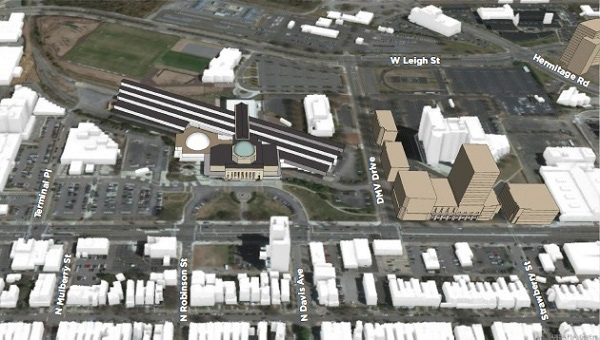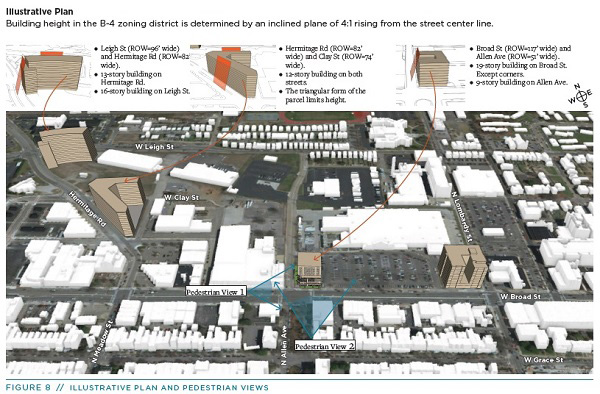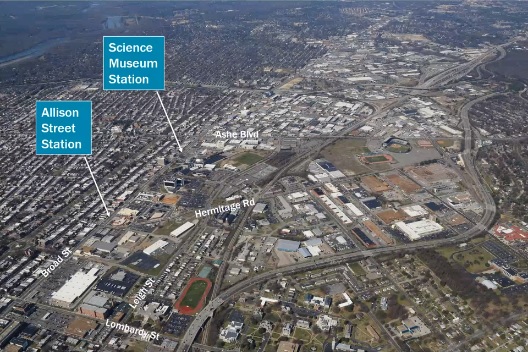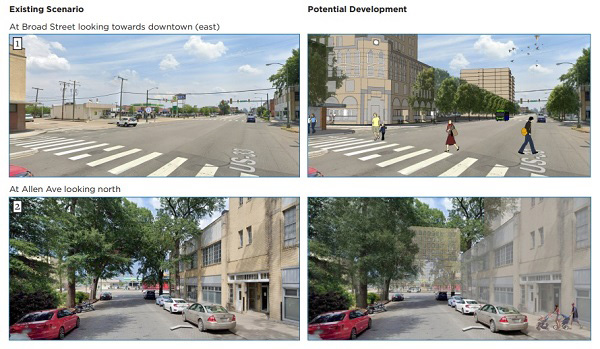
New renderings show potential building heights along Broad Street and Hermitage Road near the Science Museum of Virginia. (Images courtesy city of Richmond)
After delaying a vote earlier this month, the Richmond City Council is again slated to consider the latest round of proposed zoning changes tied to the city’s Pulse Corridor Plan, despite opposition from neighbors who maintain that effects of those changes would go against what’s spelled out in the plan.
The council is scheduled to vote tonight on a third phase of city-initiated rezonings meant to fulfill goals of the plan, which the council adopted in 2017 to guide development in the area of the GRTC Pulse bus-rapid-transit line.
Following previous rezonings in the Scott’s Addition area and the bulk of Monroe Ward, this latest round focuses on land primarily north of Broad Street across from the Fan, in and around the Carver and Newtowne West neighborhoods generally between Belvidere Street and the DMV headquarters building.
The primarily manufacturing-zoned properties also include parcels between Leigh Street and the railroad tracks in the area of Hermitage Road and Lombardy Street. Most of the properties are proposed to be rezoned to the city’s B-4 Central Business District.
Intended to encourage higher-density development in those areas, the changes in some cases would allow building heights of 20 stories or more, including several spots along Broad directly across from the Fan, a primarily residential area with considerably shorter buildings.
Existing zoning along the north side of Broad currently restricts building heights to between four and 5½ stories, with existing B-4 zoning at DMV and east of Harrison Street allowing greater heights based on a four-to-one “inclined plane” ratio, which allows 4 feet in height for every 1 foot in width from the center of adjacent right-of-way.

An image shows potential building heights based on the four-to-one ‘inclined plane’ ratio that’s based on adjoining right-of-way.
The proposed changes would rezone that entire stretch of Broad to B-4, which in some places — based on the width of the multilane street — could result in allowable building heights of 20 stories or more, such as in front of the Lowe’s Home Improvement and Kroger stores, at Sauer Center and in front of and around the DMV building. Corner buildings adjacent to cross streets would be measured according to those smaller right-of-ways.
The prospect of such towering structures looming across Broad is the primary concern of a group of eight neighborhood and civic associations that have asked the city to hold off on the rezonings, which they describe as being forced through and unnecessary in the midst of a pandemic.
“City Hall is 19 stories tall. Can you imagine that next to the Fan? It just doesn’t make any sense,” said Jonathan Marcus, a West Grace Street resident and president of RVA Coalition of Concerned Civic Associations, which is part of the group that includes associations for Carver and Newtowne West.
Marcus, also a board member for the Historic West Grace Street and Fan District associations, which round out the group along with the Fan Area Business Association and Monument Avenue Preservation Society, criticized the city’s public engagement on the rezonings, which has been underway for two years. He said officials have not been forthcoming about the 20-plus-story building height potential, which he said goes against the Pulse Corridor Plan.
“At the crux of (our) questions and concerns is the fact that the Pulse Corridor Plan specifies a height limit of 12 stories. The new zoning allows over 20 stories depending on the specific parcel. This defiance of the Pulse Corridor Plan has never been addressed,” Marcus said.
He added, “That’s frustrating to say the least. We are taxpaying citizens, and we are eight neighborhood organizations who have asked for true engagement, and we don’t get true engagement; we get the appearance of engagement. None of the questions we have asked have truly been answered.”
Plan calls for ‘high-density’
Anne Darby, a city planner involved in the proposal who has met with some of the groups, said Friday that the Pulse plan includes a corridor-wide recommendation of mid-rise, mixed-use buildings up to 12 stories in height, but doesn’t specify where that district should be applied, as it was with the TOD-1 “transit-oriented development” zoning applied along Broad at Scott’s Addition.

An aerial view of the area that’s the focus of this phase, generally north of Broad Street to the railroad tracks and between Lombardy Street and Arthur Ashe Boulevard.
She said the Pulse plan also recommends a future land use designation called “Nodal Mixed-Use” in the area recommended for B-4 zoning. That designation is described as consisting of “high-density buildings” with “typically a minimum height of five stories.”
The rezonings also would come with a proposed development plan overlay that city planners would use to determine if projects meet the Pulse plan’s design guidelines and “is in keeping with the character of the immediate surroundings.”
Marcus maintained that the Pulse plan also allows for creation of new zoning districts that he said could be applied to better regulate building heights in specific areas. He said the neighborhood groups are not anti-development and could be amenable to 12-story buildings on the north side of Broad, as is expected from a project recently approved at Broad and Lombardy streets.
“We live in the city. We like the urban life,” Marcus said. “We want Broad Street to be more and more rejuvenated. We want higher density. We want new business and new residents and new economic activity. All of that can be accomplished by maintaining the character and scale of the city.”
New renderings show possible heights
Since the council deferred a vote at its Sept. 14 meeting, with members citing the neighborhood groups’ opposition, city planners have created a new Phase III summary that more clearly refers to and highlights consistencies with the Pulse plan. It also includes new renderings that show potential building heights that could result in the area.
The images show a tall building and adjoining smaller buildings filling the surface parking lots that surround the DMV building. They also show buildings along Hermitage Road, at Leigh Street and at Clay Street, that could reach heights of 12 to 16 stories based on the four-to-one “inclined plane” ratio with adjacent roads.
Those Hermitage Road properties are among the considerable land holdings of Sauer Properties, the real estate arm of Richmond’s Sauer family that’s wrapping up the Whole Foods-anchored first phase of Sauer Center, a massive mixed-use development taking shape at Hermitage and Broad.
Sauer’s holdings include additional properties along Broad Street and undeveloped land on both sides of Hermitage that make up the bulk of the proposed rezoning.
Ashley Peace, president of Sauer Properties, said the group is in the midst of a master planning process for development of the rest of those properties, but she said they’ve been waiting to see what happens with the rezoning, which Peace voiced support for in a recent hearing before the Planning Commission.
“We have a lot more to do and a lot more that we can do, and we’ve just been waiting to see if the city was going to pass this rezoning initiative, because that really would give us the flexibility to develop a Class A mixed-use project there,” said Peace, who told the commission such development would include medium- to high-density uses including office and residential.
“We have the potential to develop almost a new neighborhood that a market like Richmond has never seen before, but which is very common in all other major markets — particularly throughout the Southeast,” she said. “We understand the importance of that, and that we get one shot and it has to be done very well.”
Describing the rezonings as more important for the city as a whole, Peace added, “Obviously we need economic development opportunities, and that stretch of Broad Street has been a planning corridor and a high priority with the Pulse rapid transit for many, many years. By happenstance, the majority of our property lies in that planning corridor.”
The City Council’s regular meeting starts at 6 p.m.

New renderings show potential building heights along Broad Street and Hermitage Road near the Science Museum of Virginia. (Images courtesy city of Richmond)
After delaying a vote earlier this month, the Richmond City Council is again slated to consider the latest round of proposed zoning changes tied to the city’s Pulse Corridor Plan, despite opposition from neighbors who maintain that effects of those changes would go against what’s spelled out in the plan.
The council is scheduled to vote tonight on a third phase of city-initiated rezonings meant to fulfill goals of the plan, which the council adopted in 2017 to guide development in the area of the GRTC Pulse bus-rapid-transit line.
Following previous rezonings in the Scott’s Addition area and the bulk of Monroe Ward, this latest round focuses on land primarily north of Broad Street across from the Fan, in and around the Carver and Newtowne West neighborhoods generally between Belvidere Street and the DMV headquarters building.
The primarily manufacturing-zoned properties also include parcels between Leigh Street and the railroad tracks in the area of Hermitage Road and Lombardy Street. Most of the properties are proposed to be rezoned to the city’s B-4 Central Business District.
Intended to encourage higher-density development in those areas, the changes in some cases would allow building heights of 20 stories or more, including several spots along Broad directly across from the Fan, a primarily residential area with considerably shorter buildings.
Existing zoning along the north side of Broad currently restricts building heights to between four and 5½ stories, with existing B-4 zoning at DMV and east of Harrison Street allowing greater heights based on a four-to-one “inclined plane” ratio, which allows 4 feet in height for every 1 foot in width from the center of adjacent right-of-way.

An image shows potential building heights based on the four-to-one ‘inclined plane’ ratio that’s based on adjoining right-of-way.
The proposed changes would rezone that entire stretch of Broad to B-4, which in some places — based on the width of the multilane street — could result in allowable building heights of 20 stories or more, such as in front of the Lowe’s Home Improvement and Kroger stores, at Sauer Center and in front of and around the DMV building. Corner buildings adjacent to cross streets would be measured according to those smaller right-of-ways.
The prospect of such towering structures looming across Broad is the primary concern of a group of eight neighborhood and civic associations that have asked the city to hold off on the rezonings, which they describe as being forced through and unnecessary in the midst of a pandemic.
“City Hall is 19 stories tall. Can you imagine that next to the Fan? It just doesn’t make any sense,” said Jonathan Marcus, a West Grace Street resident and president of RVA Coalition of Concerned Civic Associations, which is part of the group that includes associations for Carver and Newtowne West.
Marcus, also a board member for the Historic West Grace Street and Fan District associations, which round out the group along with the Fan Area Business Association and Monument Avenue Preservation Society, criticized the city’s public engagement on the rezonings, which has been underway for two years. He said officials have not been forthcoming about the 20-plus-story building height potential, which he said goes against the Pulse Corridor Plan.
“At the crux of (our) questions and concerns is the fact that the Pulse Corridor Plan specifies a height limit of 12 stories. The new zoning allows over 20 stories depending on the specific parcel. This defiance of the Pulse Corridor Plan has never been addressed,” Marcus said.
He added, “That’s frustrating to say the least. We are taxpaying citizens, and we are eight neighborhood organizations who have asked for true engagement, and we don’t get true engagement; we get the appearance of engagement. None of the questions we have asked have truly been answered.”
Plan calls for ‘high-density’
Anne Darby, a city planner involved in the proposal who has met with some of the groups, said Friday that the Pulse plan includes a corridor-wide recommendation of mid-rise, mixed-use buildings up to 12 stories in height, but doesn’t specify where that district should be applied, as it was with the TOD-1 “transit-oriented development” zoning applied along Broad at Scott’s Addition.

An aerial view of the area that’s the focus of this phase, generally north of Broad Street to the railroad tracks and between Lombardy Street and Arthur Ashe Boulevard.
She said the Pulse plan also recommends a future land use designation called “Nodal Mixed-Use” in the area recommended for B-4 zoning. That designation is described as consisting of “high-density buildings” with “typically a minimum height of five stories.”
The rezonings also would come with a proposed development plan overlay that city planners would use to determine if projects meet the Pulse plan’s design guidelines and “is in keeping with the character of the immediate surroundings.”
Marcus maintained that the Pulse plan also allows for creation of new zoning districts that he said could be applied to better regulate building heights in specific areas. He said the neighborhood groups are not anti-development and could be amenable to 12-story buildings on the north side of Broad, as is expected from a project recently approved at Broad and Lombardy streets.
“We live in the city. We like the urban life,” Marcus said. “We want Broad Street to be more and more rejuvenated. We want higher density. We want new business and new residents and new economic activity. All of that can be accomplished by maintaining the character and scale of the city.”
New renderings show possible heights
Since the council deferred a vote at its Sept. 14 meeting, with members citing the neighborhood groups’ opposition, city planners have created a new Phase III summary that more clearly refers to and highlights consistencies with the Pulse plan. It also includes new renderings that show potential building heights that could result in the area.
The images show a tall building and adjoining smaller buildings filling the surface parking lots that surround the DMV building. They also show buildings along Hermitage Road, at Leigh Street and at Clay Street, that could reach heights of 12 to 16 stories based on the four-to-one “inclined plane” ratio with adjacent roads.
Those Hermitage Road properties are among the considerable land holdings of Sauer Properties, the real estate arm of Richmond’s Sauer family that’s wrapping up the Whole Foods-anchored first phase of Sauer Center, a massive mixed-use development taking shape at Hermitage and Broad.
Sauer’s holdings include additional properties along Broad Street and undeveloped land on both sides of Hermitage that make up the bulk of the proposed rezoning.
Ashley Peace, president of Sauer Properties, said the group is in the midst of a master planning process for development of the rest of those properties, but she said they’ve been waiting to see what happens with the rezoning, which Peace voiced support for in a recent hearing before the Planning Commission.
“We have a lot more to do and a lot more that we can do, and we’ve just been waiting to see if the city was going to pass this rezoning initiative, because that really would give us the flexibility to develop a Class A mixed-use project there,” said Peace, who told the commission such development would include medium- to high-density uses including office and residential.
“We have the potential to develop almost a new neighborhood that a market like Richmond has never seen before, but which is very common in all other major markets — particularly throughout the Southeast,” she said. “We understand the importance of that, and that we get one shot and it has to be done very well.”
Describing the rezonings as more important for the city as a whole, Peace added, “Obviously we need economic development opportunities, and that stretch of Broad Street has been a planning corridor and a high priority with the Pulse rapid transit for many, many years. By happenstance, the majority of our property lies in that planning corridor.”
The City Council’s regular meeting starts at 6 p.m.




As someone who lives nearby, and has property even closer, I haven’t really heard any neighborhood opposition to this. I’m sure the people quoted don’t like it, but the vast vast majority doesn’t really care what happens on the north of broad street, within reason.
And we’d vastly prefer tall, nice, development to the mess that’s there in many places.
City has been doing what it does best; keep public opinion and review at bay. Joint statement from several civic associations. Some even have supporters of the rezoning but the process smells. September 25, 2020 The failure to share public business correspondence when requested by citizens is an obstruction of the FOIA process. The City Council vote cannot fairly proceed on a critical vote proposed by the Planning Department while the Planning Department refuses timely delivery of public information in a formal FOIA request. The rezoning vote must be deferred. We all must ask: What are they hiding? Seven neighborhoods organizations… Read more »
YIMBY
Hey Charles! Y’all may not have heard much about it because the Broad Street area north of you – Scotts Addition across from the Museum District – was already rezoned and is limited to 12 stories. That’s what we were told TOD1 meant, and that’s what we expected. 20+ story building height across from the Fan is absurd. All seven adjacent neighborhood associations – LITERALLY ALL 7 – object to the B4 zoning. As does the Fan Area Business Alliance. So I must respectfully disagree with your statement. I hope you are well.
Good to see your name! Is it 20 though? That’s the bit that’s unclear from everything. I’m not sure I even see a problem with 20, but I’m definitely happy to see 12 there. The lack of clarity could be improved on by the city, but I don’t see a conspiracy necessarily, just the usual city bumbling
What they really need to do is show what the view of buildings with those heights will be from different spots in the Fan to see if you can even see them. That may allay some of the fears that there will be buildings leaning over the area.